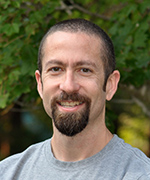Colleagues: Recently Tenured
BIBIANA BIELEKOVA, M.D., NIAID
Senior Investigator and Chief, Neuroimmunological Diseases Section, National Institute of Allergy and Infectious Diseases

Education: Comenius University School of Medicine, Bratislava, Slovakia (M.D.)
Training: Medical internship, SUNY Downstate Medical Center (Brooklyn, New York); neurology residency, Boston University School of Medicine (Boston); neuroimmunology fellowship in NINDS’s Neuroimmunology Branch
Came to NIH: In 1997 for training; staff clinician in NINDS (2000-2005); left NIH to be a tenured associate professor of neurology and director, Waddell Center for MS, University of Cincinnati (Cincinnati, Ohio); returned to NIH in 2008 as an investigator in NINDS
Selected professional activities: Elected fellow of the American Academy of Neurology; elected fellow of the American Neurological Association; reviewer for several journals; co-organizer of a multiple sclerosis (MS) biomarker workshop, a Center for Human Immunology workshop, and the Spinal Fluid Consortium for MS
Outside interests: Taking photographs; hiking; volunteering on medical missions in developing nations
Website: https://irp.nih.gov/pi/bibiana-bielekova
Research interests: My laboratory is studying the mechanisms of immunoregulation and immune-mediated central nervous system (CNS) tissue injury in multiple sclerosis (MS) and other neuroimmunological diseases. Our long-term goal is to develop effective therapies for these diseases. Because observational studies cannot determine causal relationships, we use proof-of-principle interventional trials supported by biomarker/mechanistic studies and mathematical/statistical modeling to investigate major hypotheses about the pathophysiology of MS.
Because immunomodulatory treatments do not work well for progressive MS, it was believed that progressive MS is mainly a neurodegenerative disease. We demonstrated that the levels of CNS inflammation are the same for patients with progressive MS and those with relapsing-remitting MS. The multiplicity of potential pathogenic processes in progressive MS makes it unlikely that a single therapeutic agent will have major clinical efficacy. Effective therapy will require combinations of therapeutics that target patient-specific drivers of disability.
To produce such combination treatments, we must reliably measure the diverse CNS pathophysiological processes in living people and thereby define process-specific biomarkers to use as outcomes in Phase 2 trials. Indeed, using cerebrospinal fluid (CSF) biomarkers and statistical learning we have defined (and validated in an independent cohort) molecular signatures that differentiate MS from other CNS diseases and predict rates of MS progression. Our goal is to formulate (and validate) a framework in which CSF biomarker-based models provide reliable diagnostic, prognostic, and therapeutically predictive information that will empower neurologists to practice precision medicine.
Among my lab’s scientific achievements is the development of a CSF-based test that identifies and quantifies compartmentalized CNS inflammation specific for T cells, B cells, and monocytes/macrophages without the need for a brain biopsy. In addition, we used statistical learning to develop a CSF-based molecular diagnostic test that can differentiate MS from other CNS diseases (including inflammatory). We also developed much more sensitive measures of clinical outcomes and a MS disease-severity scale (MS-DSS) that can be used to predict the progression of the disease.
STEPHEN GILMAN, SC.D., NICHD
Senior Investigator, Social and Behavioral Sciences Branch, Division of Intramural Population Health Research, National Institute of Child Health and Human Development

Education: Tufts University, Medford, MA (B.A., social psychology); Harvard School of Public Health, Boston (Sc.M. and Sc.D. in health and social behavior)
Training: Postdoctoral fellowship in behavioral medicine, Brown Medical School (Providence, Rhode Island)
Before coming to NIH: Associate professor, Department of Social and Behavioral Sciences and Department of Epidemiology, Harvard School of Public Health
Came to NIH: In 2015
Selected professional activities: Adjunct professor, Department of Mental Health, Johns Hopkins Bloomberg School of Public Health; elected fellow and councilor, American Psychopathological Association; member, Education Committee, Society for Epidemiologic Research; associate editor, Nicotine & Tobacco Research
Website: https://irp.nih.gov/pi/stephen-gilman
Research interests: Common mental disorders—depression, anxiety, and substance-use disorders—account for a substantial portion of the global burden of disease. My group investigates the life-course epidemiology of common mental disorders with an emphasis on understanding their developmental origins. Given that there are substantial social inequalities in common mental disorders, we also seek answers to the question “Why do social inequalities in common mental disorders emerge early in the life course, persist into adulthood, and become transmitted to the next generation?”
We are investigating the mechanisms for the link between disadvantaged childhood environments and the onset and recurrence of mood and substance disorders in childhood and adulthood. Discovering the mechanisms that produce social inequalities in psychopathology is integral to advancing our understanding of the developmental origins of psychiatric disorders.
This research has directed our focus on neurodevelopment as a key underlying pathway. For example, in one recent study, we found that neurologic abnormalities in infancy were more likely to occur in the context of socioeconomic disadvantage; in part the abnormalities were associated with lower concentrations of the proinflammatory cytokine interleukin-8 in prenatal serum during mid to late gestation. This work suggests that stress-immune mechanisms are one potential pathophysiologic pathway involved in the early origins of population-health inequalities. Other work in progress involves examining neurodevelopmental and other early childhood risk factors for suicide, a leading cause of death among young people.
RAPHAELA GOLDBACH-MANSKY, M.D., M.H.S., NIAID
Senior Investigator and Chief, Translational Autoinflammatory Disease Studies Section, National Institute of Allergy and Infectious Diseases

Education: Universität Witten/Herdecke Medical School, Witten, Germany (M.D.); Duke, Durham, North Carolina (M.H.S.)
Training: Postdoctoral research fellow, Memorial Sloan-Kettering Cancer Center (New York); combined residency in internal medicine and pediatrics, Case Western Reserve University, MetroHealth Medical Center (Cleveland, Ohio); and rheumatology fellowship at NIAMS
Came to NIH: In 1997 for training; became staff clinician in 2001 and tenure-track investigator in 2008 in NIAMS; in 2016 became tenure-track investigator in NIAID
Selected professional activities: Founder of the trans-NIH Translational Autoinflammatory Research Initiative; editorial board member of Rheumatology, JCI Insight, and Frontiers in Immunology; reviewer for several other journals
Outside interests: Reading about and studying world and art history; hiking; gardening; and listening to classical music
Website: https://irp.nih.gov/pi/raphaela-goldbach-mansky
Research interests: My translational autoinflammatory research program focuses on children who have early-onset autoinflammatory diseases (immune dysregulatory diseases with excessive sterile inflammation that cause organ dysfunction and damage). My research team conducts pathogenesis and treatment studies in patients who have interleukin-1 (IL-1)-mediated autoinflammatory diseases—including neonatal-onset multisystem inflammatory disease (NOMID) and deficiency of the IL-1 receptor antagonist (DIRA)—and in patients with the type I interferon (IFN)-mediated autoinflammatory diseases, CANDLE and SAVI. Furthermore, we evaluate and study patients with undifferentiated autoinflammatory diseases that respond poorly to treatment.
We apply a diagnostic approach that includes careful clinical, genetic, and immune evaluations. We are part of the NIAID Clinical Genomics Program and aim to identify novel genetic variants that cause or modify inflammatory disease phenotypes.
With the goal of translating clues from early pathogenic and genetic studies into novel treatments, we develop treatment studies for our patients. Past studies using treatments that block IL-1 signaling confirmed a key role for the proinflammatory cytokine IL-1 in causing the disease manifestations of NOMID and DIRA. Our work led to the FDA’s 2012 approval of the IL-1-blocking agent anakinra for the treatment of NOMID. More recently we identified diseases presenting with chronically elevated blood IFN signatures suggesting excessive IFN signaling (in CANDLE and SAVI). Treatment in a compassionate program using a JAK inhibitor that blocks IFN signaling confirmed a key role for IFN in causing the disease.
Many genetically defined autoinflammatory diseases have become models for understanding the pathogenesis of more common inflammatory diseases and are providing models for treatment.
Our work benefits from the NIH Clinical Center’s help in phenotyping patients; conducting interventional studies; and providing inpatient- and outpatient-care facilities, laboratory services, and first-class imaging modalities. My active collaborations with specialists in many NIH institutes and the NIH Clinical Center’s radiology and physical therapy department are crucial in our studies and in supporting our patients.
NASSER RUSAN, PH.D., NHLBI
Senior Investigator, Laboratory of Molecular Machines and Tissue Architecture, National Heart, Lung, and Blood Institute

Education: University of Massachusetts, Amherst, Massachusetts (B.A. in biology and Ph.D. in molecular and cellular biology)
Training: Postdoctoral training, University of North Carolina (Chapel Hill, North Carolina)
Came to NIH: In 2011 as an Earl Stadtman Investigator in NHLBI
Selected professional activities: Editorial board member of Molecular Biology of the Cell and of Frontiers in Developmental and Cell Biology; chair of the Drosophila Image Award (sponsored by the Genetics Society of America)
Website: https://irp.nih.gov/pi/nasser-rusan
Research interests: My lab studies the role of centrosomes during animal development. The centrosome is a non-membrane bound organelle that serves as the main microtubule organizing center of most animal cells. Centrosomes help build mitotic spindles, which are the molecular machines required for chromosome separation during cell division. Given the importance of cell division for proper development and tissue maintenance, it is not surprising that defects in centrosome function lead to a wide range of failures at the cellular level, which in turn, lead to tissue defects and many human diseases.
My lab is trying to determine how centrosomes are properly constructed from their individual parts and how they function in a wide range of cell types to avoid human diseases such as polycystic kidney disease, microcephaly, cancer and many others. We have streamlined a system to investigate multifunctional centrosome proteins and figure out how they play unique roles in different developmental stages, cell types, and cell-cycle stages. Using Drosophila genetics, cell biology, super-resolution microscopy, biochemistry, and modern molecular biology, we have uncovered unexpected new roles for centrosome proteins including in interphase neural stem cells during embryogenesis and spermatogenesis.
We have found that diversity in protein-protein interactions networks is responsible for the diversity of centrosome functions across cell types and cell-cycle stages. In other words, not all centrosomes are made equally. Understanding this centrosome diversity is a priority because it could help explain why different mutations in centrosome proteins affect specific cell types and manifest different diseases.
My laboratory is also venturing into developmental neurobiology. This direction started as a project aimed at investigating centrosomes as microcephaly-suppressor organelles. We have now expanded our research well beyond the centrosome, taking a hardcore cell-biology approach to understanding brain development using all the latest imaging technologies.
HUMPHREY HUNG-CHANG YAO, PH.D., NIEHS
Senior Investigator, Reproductive Developmental Biology Group, National Institute of Environmental Health Sciences

Education: Fu-Jen University, Taipei, Taiwan (B.S. in biology); University of Illinois at Urbana, Urbana, Illinois (M.S. in animal science; Ph.D. in reproductive biology)
Training: Postdoctoral fellow in developmental biology, Duke University (Durham, North Carolina)
Before coming to NIH: Associate professor, Department of Comparative Biosciences, University of Illinois at Urbana
Came to NIH: In 2010
Selected professional activities: Chair for the 2018 Gordon Research Conference on Mammalian Reproduction; associate editor, Biology of Reproduction; editorial board member, Sexual Development and Endocrinology
Outside interests: Playing tennis and golf; cooking; being a public-speaking coach; and translating English literature to Chinese
Website: https://irp.nih.gov/pi/humphrey-yao
Research interests: My lab is defining the normal process of how gonads and reproductive tracts form during embryogenesis. We are investigating whether this process is susceptible to in utero exposure to endocrine disruptors.
Compelling animal evidence and human epidemiological data have revealed that impairments in the development of fetal organs have profound consequences on adult health. The concept of “fetal origins of adult diseases” also applies to the reproductive systems—defects in the formation of reproductive organs manifest as disorders of sex development. However, minor abnormalities often go undetected and become a potential cause of fertility problems and neoplasia when the affected individual reaches adulthood.
My group uses organogenesis of the gonads and reproductive tracts as a model for understanding the basic process of organ formation. We are trying to determine how exposure to endocrine disruptors affects the formation of reproductive organs in fetuses and fertility in adults. Reproductive organs exhibit a dramatic sex-specific pattern of dimorphic development. This unique pattern of development provides us with opportunities to understand not only the basic mechanism of sex determination, but also how progenitor cells make the decision to differentiate into tissue-specific cell types, the fundamental concept of embryology.
Disorders of sex development, which affect one in 4,500–5,500 newborns, are major birth defects with significant health and psychological impacts on patients and their families. By using genetically modified mice to model human disorders of sex development, we hope to identify the potential causes of these disorders. We hope that our research will, one day, enable doctors to make appropriate diagnoses and treatments.
This page was last updated on Thursday, April 7, 2022
